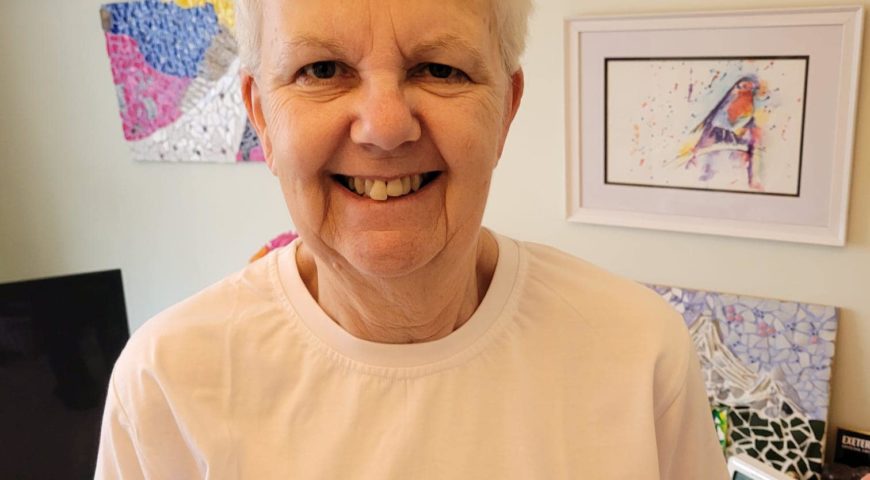Living Like a Local by Dr. Christine Tipper
For over a decade I have been visiting Nepal and immersing myself in the local culture. When I’m in Nepal, I stay with a family in the village of Duwakot, near Bhaktapur.
I like to describe myself as a multi-faceted adventurer. My defining characteristic – is my curiosity. I love learning, exploring, and discovering what our beautiful world has to offer. I’ve lived in several countries. I speak French, Spanish, and Nepali. I taught French studies, translation, and interpreting at the University of Bath, UK. I’ve worked as a professional translator and interpreter in French and Spanish. I’m a poet and a novelist. I’m an artist – I make mosaics, draw and paint.
So how did I end up in Nepal and why have I returned there over a dozen times? I first visited Nepal as a volunteer in 2012. I fell in love with the country and its people, who are kind and generous. That first year I volunteered at Glory English Secondary School. They stole my heart and I’ve returned there frequently to run English, art, and craft workshops. I’ve also organized teacher training sessions and facilitated University of Bath student placements there. Not every child in Nepal goes to school and it’s a joy to be amongst young people who value their opportunity to receive an education.
When in Nepal I live like a local. I stay with the same family, who’ve adopted me as their English grandmother. I even attended their daughter’s wedding. In Nepal family, connections are very important, something that many Western families have lost due to the pressures of modern-day life. Tihar festival celebrates brotherly and sisterly ties. The celebration of Dashain, similar to Christmas in Western cultures, is when family members visit each other’s houses where they are offered enormous amounts of food. Also, like Christmas, family members who live far away make a special effort to join their family for this important festival.
One wonderful Nepalese tradition is being offered cups of tea whenever you visit someone’s house. For an English woman, this makes me feel right at home. The Nepalese usually drink milk tea that has a hint of spice added to it. It’s delicious. Another tradition is being offered, not only cups of tea but plates of food. These can range from biscuits, and a fruit platter to a plate of dal bhat – a dish of curried vegetables, rice, and lentil soup. Nepalese hosts are very generous.
So, what’s it like living with a Nepalese family? In some ways, it’s a bit like stepping back in time. There’s pride in preparing food for the family. The wife will spend hours preparing fresh vegetables using a ‘chulesi’, an upright curved knife on a stand. She cuts the vegetables by pushing them against the extremely sharp blade. Mothers and daughters, aunts and nieces, friends and neighbours sit on mats on the ground of sun-drenched terraces and, while enjoying a chat, will, for example, sort rice together, shell peas, chop cauliflower, and other vegetables. Only seasonal vegetables are used – often grown by the family themselves on their small plot of land or bought from local markets. It is refreshing to see how Nepalese cooking respects the seasons. The diet is mainly vegetarian. Masala, spices, and chillis are cooked with vegetables to produce tasty curries served with boiled rice. It’s rare to eat desert.
Nepalese houses come in all shapes and sizes. They can range from mud-built huts to multi-storeyed houses. They do not have heating. Water tanks on roofs are heated either by the sun or, more recently, by solar panels. Many families have several generations living with them. Bedrooms are used, not only for sleeping but as the person’s main living area. The terrace or the kitchen are the areas where the family get together. I love sitting on the terrace soaking up the sun and listening to the conversations all around me. Since I first visited Nepal, I have studied Nepali, but many Nepalese can speak some English. I can spend hours watching village life unfold in front of me as I sip a cup of tea on the terrace.
Nepal is a country of awe-inspiring natural beauty. I love walking in forests, up steep pathways, and arriving at places where I can see snow-topped mountains, lush green valleys, and paddy fields cut into mountainsides. I’ve seen beautiful, wildflowers growing on verges adding bursts of colour beside dusty roads. Exotic birds and butterflies add to Nepal’s charm.
Nepal has many temples and historic buildings. One of my favourite places is Bhaktapur, which is a UNESCO World Heritage Site. The royal palace complex around Durbar Square is impressive. I’ve been lucky enough to visit many times with my host, who not only knows about the history of the place but also local hidden gems, such as the café where I drank freshly pressed sugar cane juice – amazing!
I would highly recommend visiting this beautiful country full of welcoming locals.
Dr. Christine Tipper is a member of the Society of Authors, a Translator, poet, and author in the UK.



